AMD Carrizo Part 2: A Generational Deep Dive into the Athlon X4 845 at $70
by Ian Cutress on July 14, 2016 9:00 AM ESTStock Comparison: Office Performance
All of our benchmark results can also be found in our benchmark engine, Bench.
Agisoft Photoscan – 2D to 3D Image Manipulation: link
Agisoft Photoscan creates 3D models from 2D images, a process which is very computationally expensive. The algorithm is split into four distinct phases, and different phases of the model reconstruction require either fast memory, fast IPC, more cores, or even OpenCL compute devices to hand. Agisoft supplied us with a special version of the software to script the process, where we take 50 images of a stately home and convert it into a medium quality model. This benchmark typically takes around 15-20 minutes on a high end PC on the CPU alone, with GPUs reducing the time.
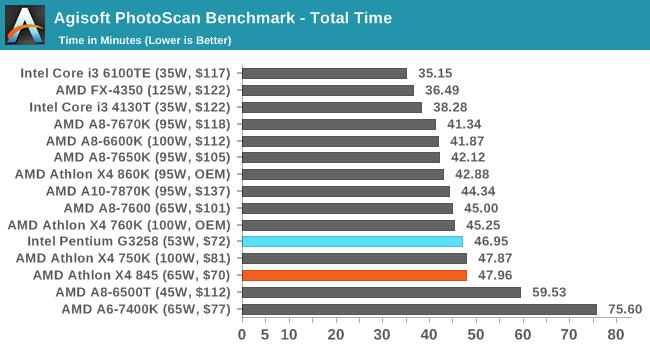
The higher IPC of the Pentium offsets the extra threads provided by the X4 845, which lags behind the other Athlons due to its reduced L2 cache size.
Cinebench R15
Cinebench is a benchmark based around Cinema 4D, and is fairly well known among enthusiasts for stressing the CPU for a provided workload. Results are given as a score, where higher is better.
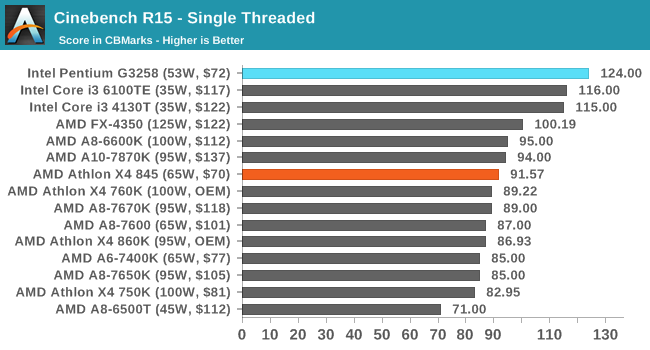
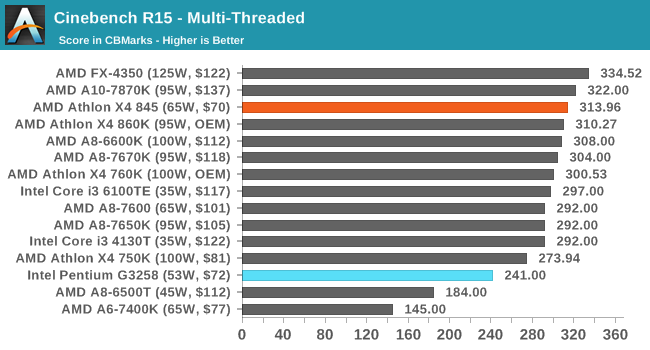
For CineBench, we see the four threads of the X4 845 in action, easily pushing a strong advantage over the Pentium in the multithreaded test. However, the Pentium does pull a 33% increase in the single threaded test due to its higher IPC.
HandBrake v0.9.9: link
For HandBrake, we take two videos (a 2h20 640x266 DVD rip and a 10min double UHD 3840x4320 animation short) and convert them to x264 format in an MP4 container. Results are given in terms of the frames per second processed, and HandBrake uses as many threads as possible.
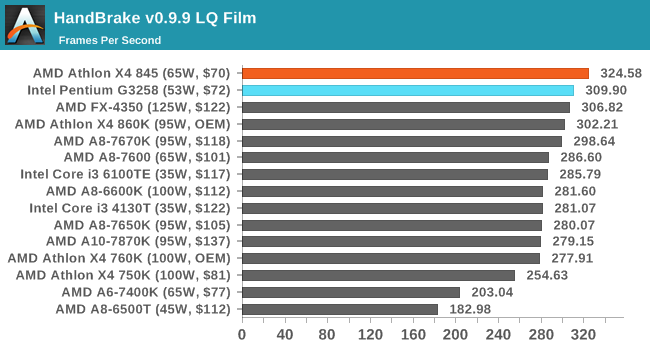
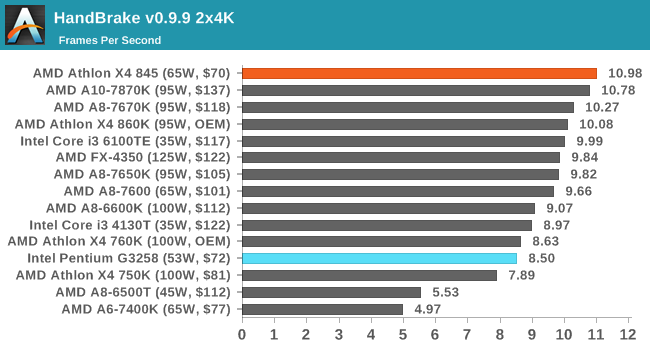
The Athlon X4 845 rules the roost in our HandBrake tests, showing what the latest AMD microarchitecture and four threads can do.
Hybrid x265
Hybrid is a new benchmark, where we take a 4K 1500 frame video and convert it into an x265 format without audio. Results are given in frames per second.
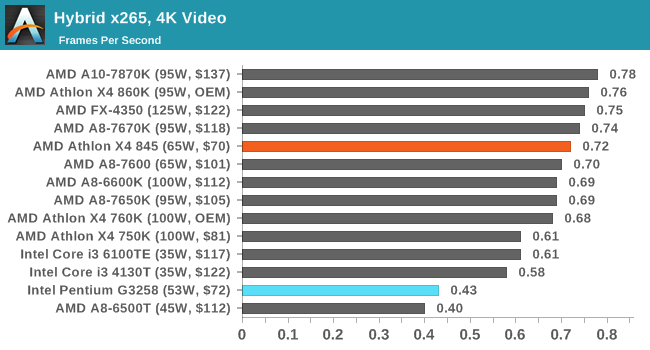
This also translates through to x265, where the dual core Pentium is lacking the ability to exploit more parallelism.










131 Comments
View All Comments
lefty2 - Thursday, July 14, 2016 - link
I'm predicting Bristol Ridge will be just as bad a failure as Carrizo. I.e. the few design wins will only have single DIMM memory and be universally unavailable, buried somewhere in a dark corner of the OEM's website. It's a pity, because both SoCs are very good in their own right.nandnandnand - Thursday, July 14, 2016 - link
If it's not Zen, it can be thrown straight in the garbage.Samus - Friday, July 15, 2016 - link
I still rock a few Kaveri desktops and they are incredibly powerful for the price. The 860K is half the cost of a comparable Intel chip, which supporting faster memory and a lower cost platform.Carizo on the desktop is an anomaly. I'd like to see what it could do with 4MB cache (would require an entirely new die)
Lolimaster - Saturday, July 16, 2016 - link
They were nice in 2014.We should have a nice 20nm 768SP APU in 2015 with a full L2 cache Excavator and fully mature 896SP 20nm early this year.
Remember the A8 3870K? That APU was a damn monster only hold back from being godly cause of their sub 3Ghz cpu speed, what we had after?
400SP VLIW5 2011 --> 384 VLIW4 2012 --> 384VLIW4 2013 --> 512SP GCN 2015 --> 512SP GCN 2016
Intel improved way faster (non "e" + edram igp's are near A8 level from being utter trash when the A8 3850 was release).
The_Countess - Tuesday, July 19, 2016 - link
yes being able to thrown in a extra billion transistors compared to AMD (1.7 vs 0.75 billion transistors for a quad core with GPU) because of 14nm really does help intel along a lot.but as nobody has been able to make a 20nm class process for anything but flash and ram besides intel, AMD's hands were tied. there is nothing AMD could have done to change that.
BlueBlazer - Friday, July 15, 2016 - link
Formula for failure: FM2 socket (with limited CPU upgradeability), only PCI Express x8 lanes available (which can bottleneck GPUs), and only "4 cores" (which performs more like 2C/4T Core i3 processor).neblogai - Friday, July 15, 2016 - link
Bristol Ridge is not FM2; PCI-E x8 can not bottleneck midrange GPUs; ultra low power mobile APU also sold as desktop chip is not a failure, just additional revenueBlueBlazer - Friday, July 15, 2016 - link
The results in the article shows otherwise, where AMD's Bristol Ridge was slower in most gaming tests, despite having better performance in some applications. Both FM2 and FM2+ are still the same (legacy) socket. AMD will be probably selling these chips at a loss. Note that these are the same (large) dies as Carrizo chips, and at 250mm^2 coupled with low prices typically meant razor thin margins or none at all.silverblue - Friday, July 15, 2016 - link
That L2 cache is probably making more difference than you realise.evolucion8 - Saturday, July 16, 2016 - link
The PCI-E is busted, even at PCI E 2.0 @ 4X, it barely makes a difference on the Fury X and the GTX 980 Ti.